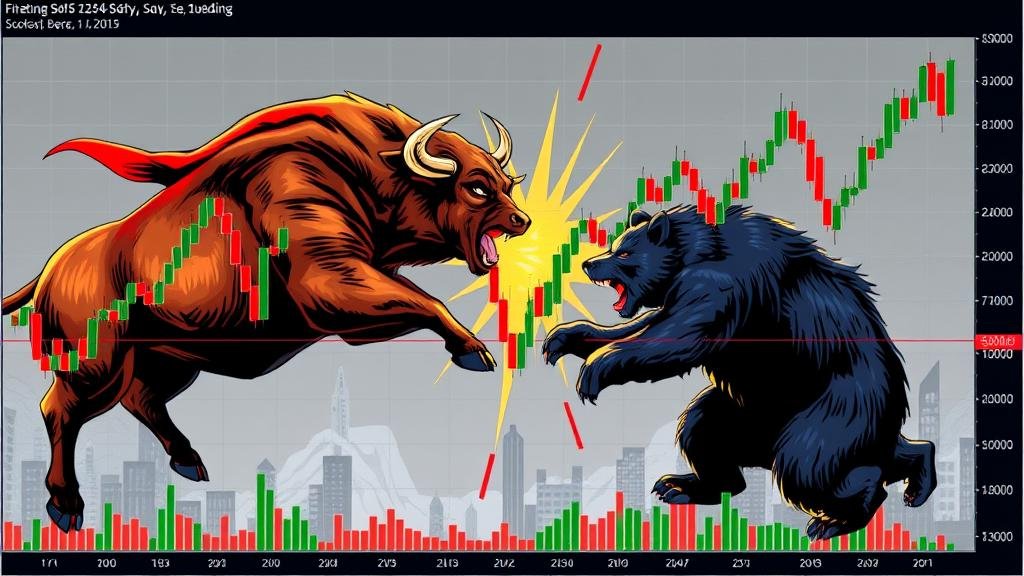Nasdaq’s Shocking Reversal: Why Tech Stocks Plunged and What Investors Should Do Now

The Nasdaq experienced a day of extreme market volatility, serving as a stark reminder of its unpredictable nature. After a promising start, the tech-heavy index saw a dramatic intraday reversal, leaving many investors wondering about the underlying causes of this sudden shift in investor sentiment.
A Day of Two Halves: The Surge and the Plunge

Initially, the market surged, with the Nasdaq climbing over 2%. This optimism was largely fueled by the ongoing AI hype and a positive interpretation of the latest economic data. For a few hours, it appeared that the bulls were firmly in control, and tech stocks were on a clear upward trajectory. However, this early confidence proved to be short-lived.
In a sudden turn of events, the market’s gains were completely wiped out in the afternoon. This swift and decisive reversal, a classic example of market volatility, indicated that the morning’s rally was built on an unstable foundation. The buying pressure evaporated, replaced by a wave of selling that pushed the index into negative territory.
Such a significant intraday reversal highlights the prevailing uncertainty in the market. But what were the catalysts for this abrupt downturn? A combination of factors appears to be responsible for spooking the market.
Analyzing the Downturn: Key Factors at Play

A sharp decline of this magnitude is rarely attributable to a single cause. Instead, it was likely the result of a confluence of anxieties that prompted a rapid sell-off.
1. Sector Rotation
One of the primary drivers of the reversal was likely sector rotation. After a period of strong performance, investors may have decided that the tech sector, particularly AI-related stocks, had become overvalued. Consequently, institutional investors began to take profits and reallocate their capital to other sectors, such as financials or energy, which appeared more attractively priced. This rotation out of tech stocks explains why the Nasdaq faltered while other indices, like the Dow Jones Industrial Average, may have shown strength.
2. Lingering Economic Fears and a Flight to Safety
Despite the morning’s optimism, concerns about the broader economic outlook continue to weigh on investors. Fears of persistent inflation, potential interest rate hikes, and the risk of a recession are creating a cautious environment. Tech stocks are generally considered “risk-on” assets, meaning they are more sensitive to economic uncertainty.
The sudden reversal suggests that a piece of news or data point may have triggered a “flight to safety,” prompting investors to sell off their growth-oriented holdings and move into less risky assets like bonds. This behavior underscores the delicate balance of investor sentiment in the current climate.
3. Profit-Taking in an Elevated Market
Following a significant run-up, especially in the AI sub-sector, many investors were sitting on substantial unrealized gains. The morning rally may have presented the perfect opportunity for them to engage in profit-taking and secure their returns. This can create a cascading effect: as more investors sell, the downward pressure on prices increases, which can trigger automated sell orders and fuel further panic-selling.
What This Means for Your Investment Strategy

Watching the market execute such a dramatic reversal can be unnerving. However, it’s crucial to respond rationally rather than emotionally. Here are a few key takeaways for investors:
- Avoid Panic-Selling: Making impulsive decisions during a market dip is one of the most common mistakes investors make. It’s essential to remain calm and stick to your long-term investment plan.
- Emphasize Diversification: This event serves as a critical lesson in the importance of diversification. A portfolio heavily concentrated in a single sector is exposed to significant risk. Spreading your investments across various sectors can help mitigate the impact of market volatility.
- Maintain a Long-Term Focus: For long-term investors, daily market fluctuations are merely noise. If the fundamental reasons for owning a particular stock remain intact, a single day of volatility should not alter your strategy. Successful investing is a marathon, not a sprint.